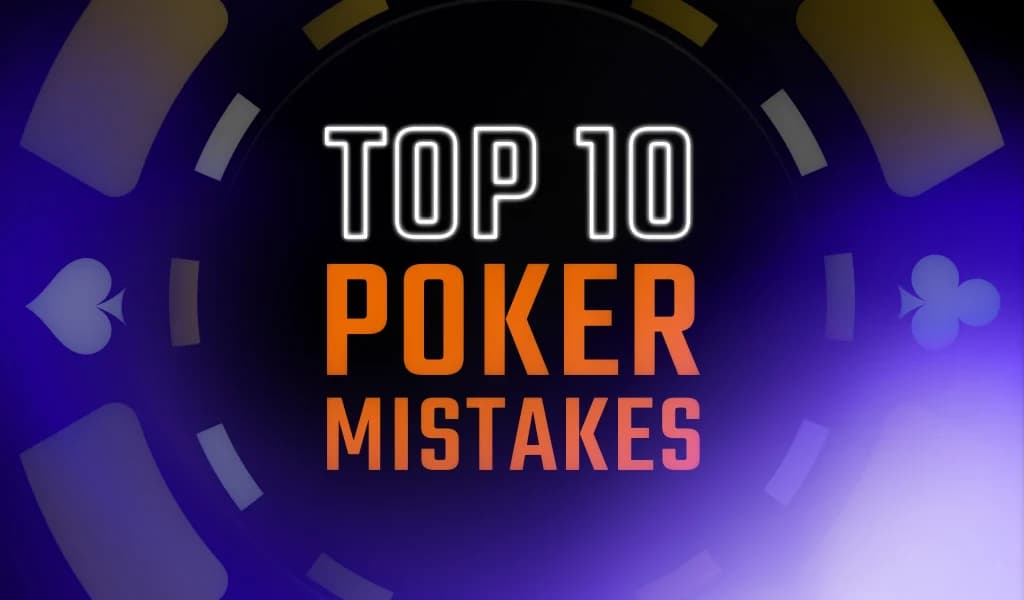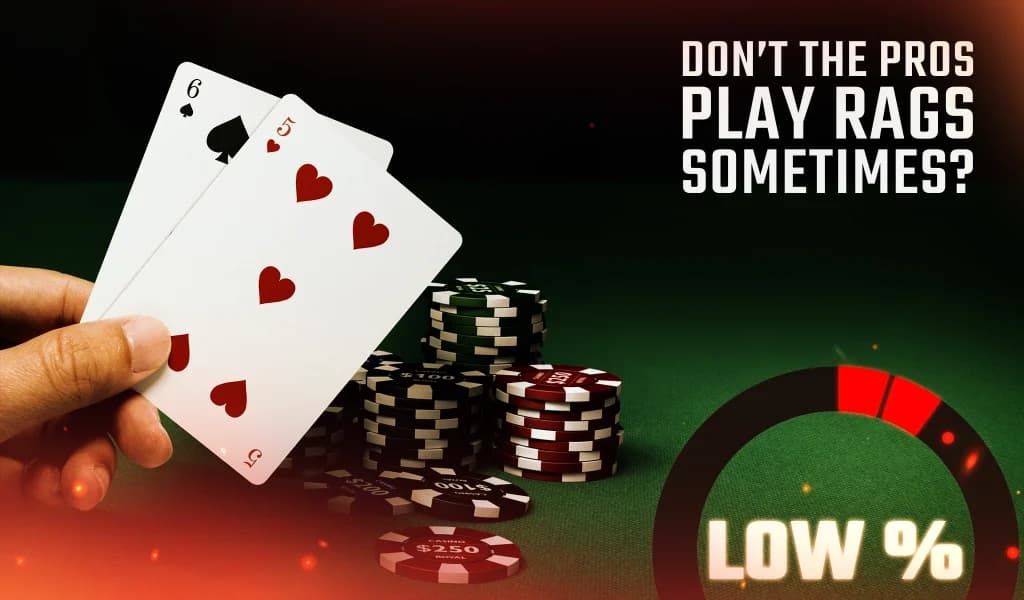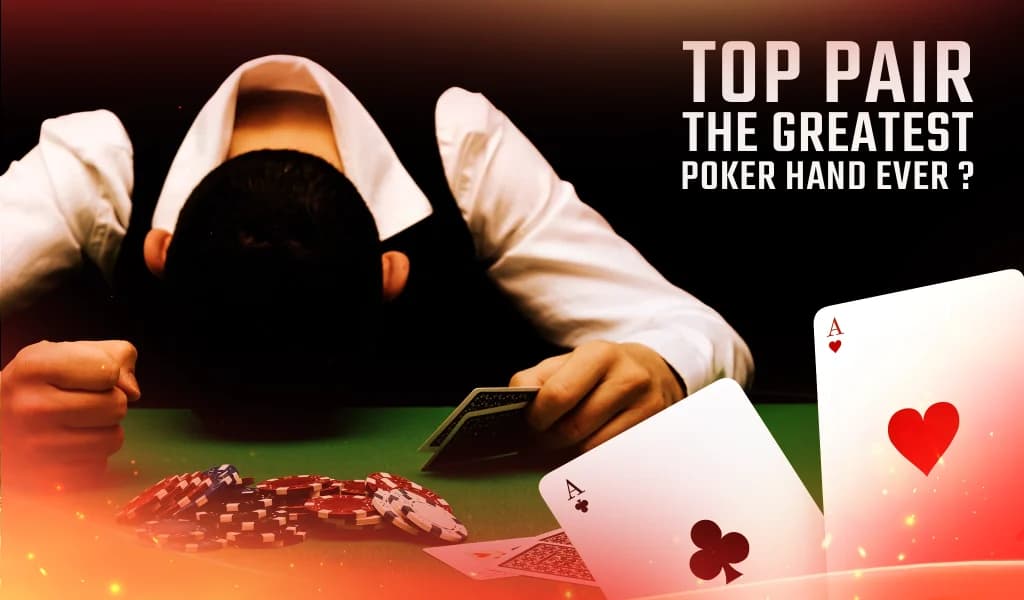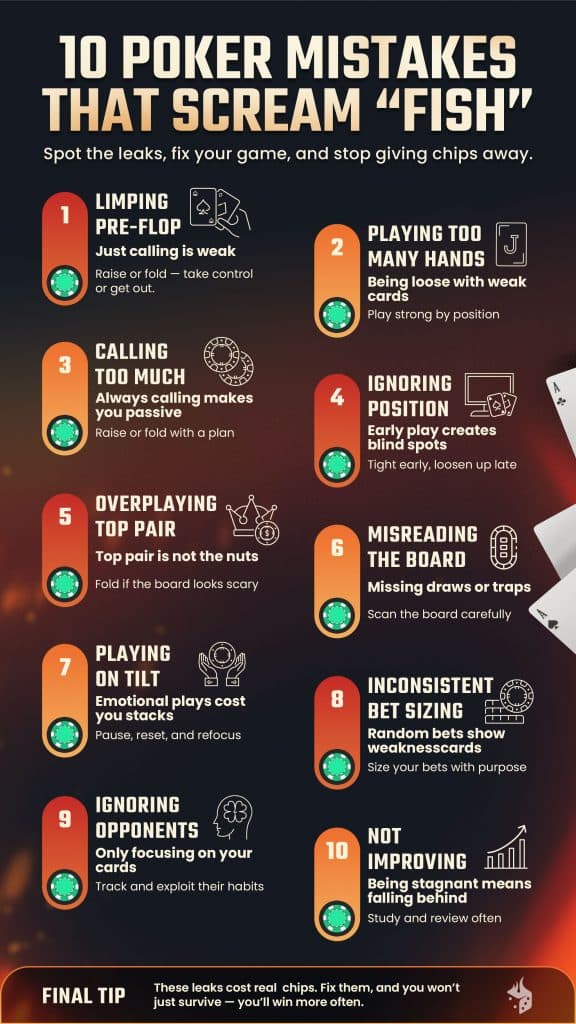
Everyone wants to be the shark at the poker table, not the fish. The fish is the player who gets taken advantage of and gobbled up by the competition. But the truth is, we all have a little fish in us from time to time. This is especially true when we’re new to the game and just getting our fins wet. Even poker pros make mistakes. To avoid leaks in your poker strategy and keep your game sharp, we’ve put together this helpful video:
Preflop Play
A common mistake poker players make is limping in (just calling the ante preflop). This is bad, especially from early positions. It signals to players that your hand isn’t that great, and invites them to raise to take control of the hand and isolate you heads up and out of position. Use respectable starting hand standards, and either raise or fold. Take the initiative or get out of the way, essentially.
Follow Good Starting Standards
Speaking of starting hands, don’t play rags too often. This is an error many players make. Low unsuited cards may seem tempting because “no one sees them coming.” But the reality is, people do see them coming, and that’s why they play premium holdings. Folks are playing AQ so that when your suited A6 makes top pair, you get outkicked. It’s often a leak in your game, and it costs you money in the majority of the hands you play. Throw in some unexpected hands, but make it a small part of your game. Active gamblers lose a lot of money by playing too loosely when the competition is staying strong and playing well. Not every player will be paying you off when you make bottom two pair, so use this strategy sparingly.
Don’t the pros play rags sometimes?

Low percentage hands have grown so much more attractive, not just due to the surprise factor, but because of pros who love to play any two cards. The difference is, they are usually doing it for a specific reason. Perhaps they are late in a tournament, and there are only a few competitors to beat. This makes it profitable to loosen up and play the person, not the cards. They also might be doing it in a televised game to make entertaining plays that will go viral. Thirdly, they can have a really good sense of how their opponent plays after thousands of hands together, and this also favors opening up their range.
If these factors aren’t present in your game, stick to what is tried and true.
Aggressive vs. Passive
Don’t be a calling station. You’ll lose too much money this way. It may be comfortable to just match the energy of your competition, but it is simply too predictable. It never really puts any pressure on anyone. You need other players to fear the possibility that you will raise the action. If they think you will just call whatever they put in, they can dictate how each hand goes. You’re putting enemies in the driver’s seat. They will bet small with most holdings, bet large with good holdings, and check with garbage.
Why Bet and Raise?
- If you have a good hand, betting forces some draws to fold and makes lesser hands pay you off.
- If you have a marginal hand or a draw, betting and raising gives you a shot at scooping the pot.
- If you have a bad hand, don’t call. Folding is often a better option than calling all the way to the river when another player is comfortable driving the action.
Stay unpredictable and keep your opponents guessing. That’s a core part of strong poker strategy. You need to inspire a little fear in your competition. A relaxed opponent will be playing thoughtfully and well, and you don’t want that. You want them a little rattled and concerned about what you might do next.
Position Matters
Don’t play the same in all positions. You’re probably not doing this exactly, but you have to adjust more if you want a strong, nuanced strategy. AK in early position is not going to play out the same way as in late position, for example. How many times have you raised it up with AK, gotten called, missed the flop, continuation bet, gotten raised, and then folded? It happens constantly with this hand. It almost seems like a losing hand, right? Well, it is if you are playing like a fish. Consider playing the line differently in early position when compared to late position. That c-bet or raise on the flop is a lot scarier when you are on the button and putting tons of pressure on your opponent to call big bets out of position with cards to come.
Top Pair = The Greatest Poker Hand Ever?

No. Obviously not. And many struggling players will go overboard with their love of top pair. You don’t have to “marry” top pair. At the end of the day, it’s only a pair. When it’s clear other players are raising and re-raising, you need to consider the possibility that top pair is no good. Be willing to let that beautiful ace jack go. Another good hand will come along.
Keep an Eye on the Board
Have you ever been surprised when you lost a hand, not even understanding what just happened? Sometimes we get tunnel vision and miss the fact that the rags on the board actually helped the big blind complete a low straight. Take a breath and literally read the board before you act. It could save you some chips.
Emotions Must Be Kept in Check
If you suffer a bad beat, take a break. It’s that simple. Don’t play tilted and don’t chase losses. You need to have discipline if you want to play winning poker and turn a profit in the long run. Many players have a sharp game, but will stack off multiple times in a row after a troubling loss. Don’t throw good money after bad. Only play when you are cool, calm, and collected.
Understand Bet Sizing Variety
There is so much complexity to bet sizing. It is a huge part of a successful poker strategy. You can’t just be that player who bets the pot whenever you have something. You need to be putting in 1/3 pot bets, ½ pot bets, overbets, and more.
When to Use Bet Sizes
Our video has a nice infographic chart, but the answer is to mix it up. Sometimes you make an overbet when you have the nuts and want to punish draws. Sometimes you do it when you have a strong draw. The goal is to be unpredictable and keep your opponents from getting a read on you. Vary the bet sizes and pursue different goals with your bets. You can build a pot, scare opponents, try to push people to fold, and more. Press different buttons, and your competition will be lost when it comes to reading your holdings.
Don’t chase the bait other players dangle. You’re not a fish, you’re doing the fishing. Good luck!



